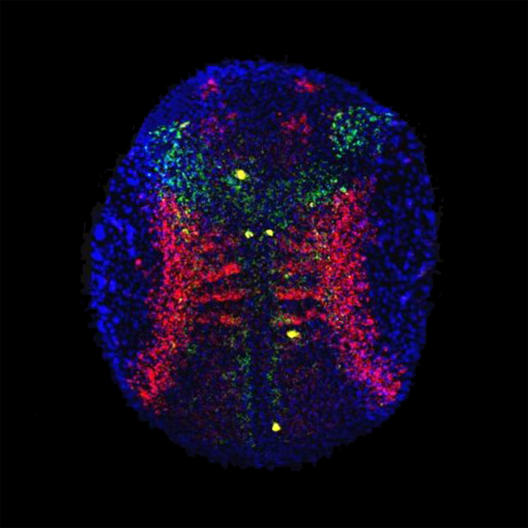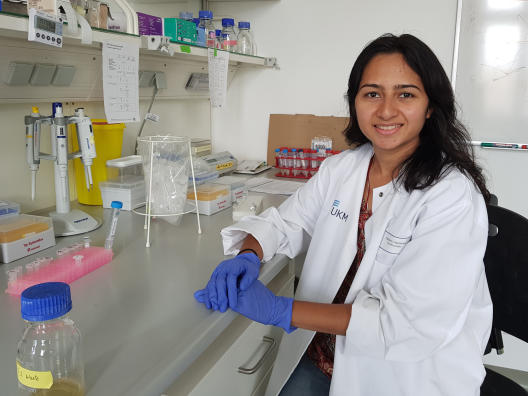Signals that guide cells through the body

Many processes in the body depend on interactions among different molecules and cells. For example, chemokines are small signalling molecules that are produced by cells and can control the behaviour of other cells. One of the things they do is guide the migration of immune cells from the blood into tissue to combat pathogens. Chemokines also play an important role during an organism’s development – for example, when organs and tissues form. In order to initiate the signalling pathways necessary for these processes, chemokines always bind to a protein on another cell, which is called a chemokine receptor. What is special about these receptors is that the same receptor can trigger different responses in healthy versus sick organisms or in different types of cells. In one type of cell, for example, it can stimulate cell growth; in another, however, it can block growth. Until recently, the mechanism behind this phenomenon was unclear. Working together with colleagues from the University of Washington, researchers of the Cells-in-Motion Cluster of Excellence at the University of Münster have now discovered that various chemokine receptors always emit the same generic signal after being activated – and that the response to the chemokine-induced signal is dictated by the cell type or cell state. The results suggest that different cell types express a certain set of molecules which are responsible for interpreting the signal. The study has been published in the journal eLife.
The detailed story:
The biologists headed by Prof. Erez Raz examined how four different chemokine receptors regulate a variety of processes during development. To this end, they first studied the primordial germ cells in live zebrafish embryos. In the embryo, primordial germ cells migrate from the place they are formed towards the region in the embryo where they are supposed to give rise to sperm and egg cells. During this migration, they are guided by chemokines that induce chemokine receptor signalling.
The researchers first examined two chemokine receptors called Cxcr4a and Cxcr4b. In order to find out whether the signals from these chemokine receptors differed from each other, the researchers genetically modified the cells to deactivate the Cxcr4b receptor, which usually ensures the primordial germ cells migrate to the correct place. To examine whether the Cxcr4a receptor can instead act as the “pilot” during cell migration, the researchers used confocal microscopy to observe the distribution of the cells in early embryos. Upon deactivating the Cxcr4b receptor from the embryo, they found that the cells migrated in random, non-directional patterns. Interestingly, introducing the Cxcr4a receptor into the germ cells instead of the Cxcr4b receptor induced the cells to migrate towards places in the embryo where the specific chemokine that binds to Cxcr4a is expressed. “This means that a chemokine and its receptor which are normally not involved in guiding the primordial germ cells were able to do so if the receptor was present on the cells” says Dr. Divyanshu Malhotra, lead author of the study and a former PhD student at the Graduate School of the Cluster of Excellence.

The finding that different receptors can control the same process was shown in another context in embryonic development, this time for a process normally controlled by the Cxcr4a receptor. In this process, specific tissues have to be correctly positioned such that organs can develop properly later. Here, the researchers found that the Cxcr4b receptor was able to “step in” in the same way and emit the necessary signals. In the same process, two further receptors with a different structure – Ccr9 and Ccr7 – were also able to take over the function of Cxcr4a.
From their results, the researchers concluded that different receptors, when activated, provide the same generic signal – contrary to what was previously assumed. Thus, the same receptor could control two different processes within the developing embryo. The researchers were able to demonstrate this principle in further experiments in other biological processes. This indicates that different cell types interpret the corresponding signal differently. The scientists have collectively named the molecules responsible for the cell-type specific response to chemokine signaling as “chemokine receptor signal interpretation modules” (CRIM). “Our results help to explain how a relatively small group of molecules can control such a wide range of processes,” says Divyanshu Malhotra.
As chemokine receptors play a key role not only during development but also in many clinically relevant processes, the discovery that different receptors generate the same signal has consequences for developing treatments. “For example, when designing drugs directed at a specific chemokine receptor or at proteins acting in the chemokine receptor signaling pathway,” says Divyanshu Malhotra, “one should now consider that the drug might also have a strong effect on other chemokine-regulated processes.”
One of the researchers’ next steps in investigating this phenomenon will focus on defining the molecular composition of the different signal interpretation modules (CRIMs). They also want to test their model in other medically relevant biological processes such as the immune response.
The study received financial support from the European Research Council, the German Research Foundation, the Medical Faculty of the University of Münster, and the National Institutes of Health in the USA.
Original publikation:
Malhotra D, Shin J, Solnica-Krezel L, Raz E. Spatio-temporal regulation of concurrent developmental processes by generic signaling downstream of chemokine receptors. Elife 2018;7: epub. Abstract

